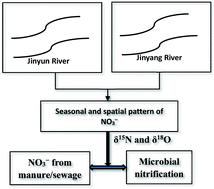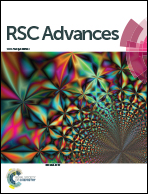Combing δ15N and δ18O to identify the distribution and the potential sources of nitrate in human-impacted watersheds, Shandong, China†
Abstract
Identifying the anthropogenic and natural sources of nitrate emissions contributing to surface water continues to be an enormous challenge. It is necessary to control the water quality in the watershed impacted by human disturbance. In this study, water chemical parameters including nitrate (NO3−) concentrations, δ15N–NO3−, δ18O–NO3−, and δ18O–H2O were analyzed to investigate the contamination and sources of NO3− in two watershed rivers (Jinyun, JYN and Jinyang, JYA), Jinan, Shandong, China. Results indicated NO3− concentrations in the JYN were significantly higher than those in the JYA (P < 0.05), probably because of high N input of the extensive farmlands or orchards in the drainage basin. δ15N–NO3− and δ18O–NO3−, associated with Cl−, indicated that nitrate-nitrogen (NO3−–N) was not derived from atmospheric deposition but came principally from manure/sewage and soil organic matter in these two watersheds. The microbial nitrification took place in the nitrate of manure/sewage and soil nitrate. The combination of NO3− concentration and nitrogen and oxygen isotope suggested that NO3− had undergone microbial denitrification after entering the rivers. Furthermore, NO3− concentrations had significant temporal and spatial variation highlighting differential sources and fates. These results expand our understanding of mechanisms driving NO3− retention and transport and provide strategies in managing NO3− contamination in different land use watersheds around the world.


 Please wait while we load your content...
Please wait while we load your content...